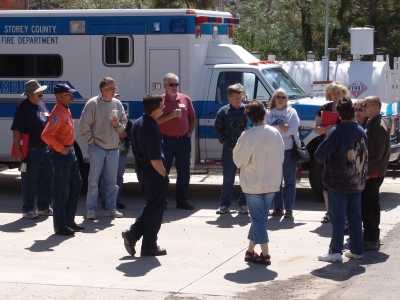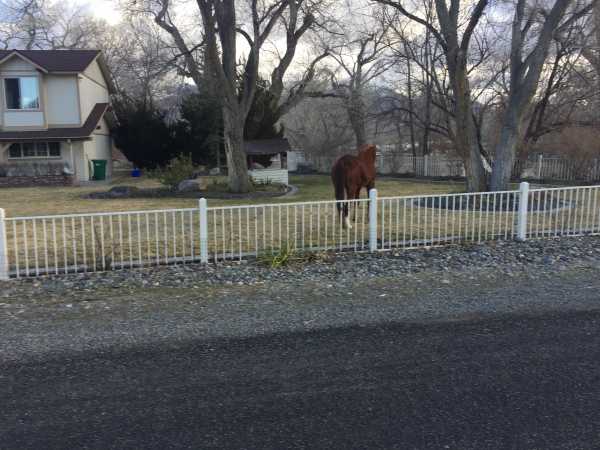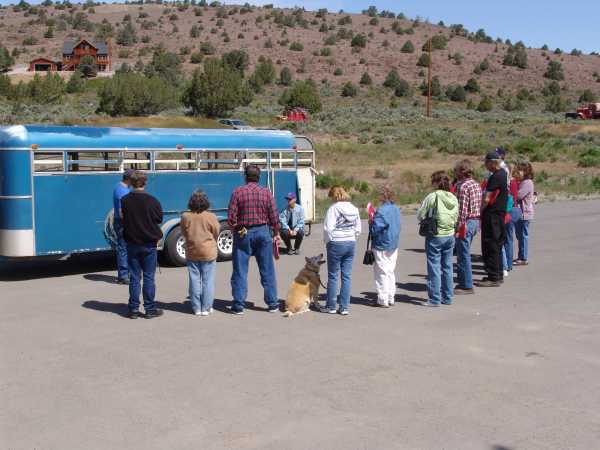|
This feature is a continuation of Part Seven.
Most successful emergency evacuation programs involve stakeholder outreach. While some people by their very nature will never be prepared, most large animal owners strive for some form of self-sufficiency and demonstrate interest in some degree of emergency planning. Often the greatest impediment involves a lack of focus combined with a general sense that if something happens, everyone will have to "just figure it out."
Finding oneself in the midst of a significant emergency event is not the best time to "just figure it out."
Oftentimes getting stakeholders together to discuss the risks
and consider what can be done can get the ball rolling.

A credible core group that has the support of public safety agencies can often engage other large animal owners, facility owners and others to encourage the formation of some form of community Large Animal Emergency Plan. One important strategy involves engaging in relevant discussions, and then proceeding beyond the mere discussion of the issues that have been identified.
Individual neighborhood and community plans will likely vary in structure and scope according to local risks and needs, but local efforts should be designed to also effectively integrate into regional response plans should an extreme event occur. Similarly, local capabilities should be organized so that volunteer responders can be effectively integrated into operations taking place in other jurisdictions should they be called upon to help.
Potential volunteers to recruit for training could come from sources such as local Mounted Search and Rescue units, law enforcement mounted auxiliaries, Backcountry Horsemen and other equestrian-based clubs or organizations, local ranchers, and others who may be experienced with handling livestock and trailering. Former fire, law enforcement, military, and persons with similar backgrounds can be very useful additions, being familiar with working in a structured command system. Including personnel from more specialized skill groups, like ham radio operators to help with communications, can also prove advantageous.
Additional personnel for field support, shelter staff, etc., might include CERT teams or other existing volunteer resources as cross-training can increase that resource type’s versatility as responders. Some volunteers may prefer to focus on sheltering or logistics while others may prefer field response.
Local resources may be familiar to incident commanders, however time and again outside resources arrive to assist an impacted community that turn out to be not effectively utilized due to lack of broader scale pre-planning and coordination. The resulting confusion and indecision impacts mission performance and wastes volunteers' time.
FEMA and state emergency management agencies can provide guidance in organizing effective emergency responses. Outreach messages should include explaining the importance of creating a local plan that can take the best advantage of outside assistance should an event become extreme. The real challenge often involves getting stakeholder attention and motivating the parties to meet, discuss and organize. Once the stakeholders are engaged, the organizational process often becomes comparatively straightforward.
To increase disaster preparedness awareness and encourage individual and community preplanning, outreach might include informational fliers distributed through local stores and other targeted public distribution. The operational area web site should include pertinent preparedness information for individuals, businesses, animals, etc. Radio public service announcements can be used. Local media can be recruited to provide informational coverage, perhaps included with coverage of local emergency/disaster training exercises with an emphasis on how individuals and the community should also be prepared.
Outreach should include providing a guest speaker with a consistent disaster preparedness message at various groups and functions. Use the month of September as National Preparedness Month. Use social media effectively. Encourage online training in Introduction to CERT if that person doesn't have time for the full CERT training. Use Neighborhood Watch programs to educate and organize for disaster preparedness. Build relationships with people, church groups, schools, organizations and businesses likely to be useful resources before, during or after a disaster. Some may have skill sets or other things they are willing to donate or discount to help the community with disaster preparedness or provide aid during response or recovery. There may be trained volunteers who can be tapped to help with the various aspects of educating the public.
Develop presentations that can be made at appropriate local club or group meetings where livestock owners are likely to be present accompanied by handouts. Post informational fliers at local feed and ranch supply stores, etc., and get those store owners involved to actively spread the word. (These businesses can also benefit by being recognizedas a resource for supplies during a disaster.) Get involved with organizations such as 4-H, FFA and Scouts to educate local youth. While educating, you are also recruiting for the future of the trained volunteer animal evacuation and sheltering program. Once a program is established, the formal evac team and support groups group can put on public disaster preparedness training specific for large animals in coordination with animal control and/or the local agriculture agency.
Educating the public as an ongoing endeavor increases the potential for the public to take responsibility for their own disaster planning, increases their safety and preparedness, and reduces the potential for their needing formal assistance. When slim local budgets are an issue, utilize trained volunteer organizations to help provide this education.
|
|
Organizational Elements to Consider
|
A sample "punch list" of organizational topics would include:
- What various local risks to large animals could be anticipated?
- How many animals (in general) are likely to be affected?
- Where are the animals located?
- Who owns the animals?
- What commercial facilities (boarding facilities, sale lots, etc.) could be affected?
- What are the capabilities and limitations of local public agencies?
- What regional resources are available and how can they be utilized?
- What sheltering resources are available (holding space, corral panels, feed, water, etc.?)
- How much are the local stakeholders willing to be involved to get organized?
- How many stakeholders are willing to train in order to operate at a credible level within an ICS structure and work effectively with incoming ICS trained resources?
- What resources can the local stakeholders bring to the table (human resources, equipment, support assets, cash donations, etc?)
- How many stakeholders are willing to commit for the long term?
- How will the response group fit into an Incident Action Plan?
If the stakeholder group appears to be viable, the following issues should be addressed.
- Identify responsibilities and how they will need to be divided.
Examples: Not everyone needs to be going out and picking up animals. Volunteers are often needed to make notifications, coordinate logistics, arrange short term and/or long term sheltering, care for sheltered animals, maintain records, and perform a number of other support functions.
- Develop some form of organizational hierarchy.
Examples: Is one person in charge? Should leadership roles be based on areas or zones? Who fills in if a designated leader is not available? (Incident command staff usually only have time to deal with leaders of response contingents, not a plethora of individual resources.)
- Identify individuals who would perform well as field responders, and organize crews and/or teams.
Examples: Response crews should never be made up of less than two people per response unit. Who should be requested and how should those volunteers be teamed up?
- Identify resources and their capabilities.
Examples: Use of straight load trailers should be limited to picking up animals that will straight load. Stock trailers are more "universal." Camelids (e.g., llamas and alpacas) should not be transported in trailers that have dividers that don't reach all the way to the floor as they tend to cush (rest sternally with legs folded underneath) and can get trapped under partial dividers. Trailers with loading panels should be assigned to difficult jobs or be paired up with trailers that don't carry panels.
- Develop a communications plan.
Examples: For safety and effectiveness, responding units need to be able to reliably communicate with each other. Group or team leaders need to be able to reliably communicate with their incident superiors. These processes need to be addressed, preferably in a way that also successfully integrates resources coming in from outside the area.
- Develop protocols that local public safety agencies recognize and approve of.
Examples: How "credentialed" responders can be identified and allowed entrance by public safety personnel, how communications will be maintained, how PAR will be maintained, how necessary records will be maintained, and the group's overall safety policy's compliance with federal, state and local standards.
An essential element of any organizational process involves identifying resource needs. Most of those needs such as trailers for transportation will likely be provided by stakeholders. Other needs may need to be funded, although some can be filled by local agencies handing down excess equipment that they no longer use.
Some resource needs may be immediately met. Others may require longer term strategies involving fundraising and/or charitable donors. Nonetheless, these needs should be identified so that filling them is on everyone's radar.
Some examples of needs typically requiring funding or material donations include:
- Loading chute panels Note 1
- Communications equipment
- Personal protective equipment (for fires, floods, etc.)
- Deployable panels for temporary shelter corrals Note 1
- Rolls of plastic construction or snow fencing
- Stock tanks for temporary shelters
- The ability to deliver water to temporary shelters
- Sources of emergency feed supplies
Note 1: The most practical panel designs are "drop pin" type that allow for quick deployment and reconfiguring as needed. Ideally the various responders in the region would agree on a standardized design to facilitate rapid interoperability if panel resources need to be combined for sheltering.
This discussion would not be complete without addressing peer to peer support options.
Oftentimes the most efficient means to safely relocate animals involves moving them short distances to safe locations within local areas. Ranches, dairies, commercial poultry operations, etc., would commonly arrange for temporary shelter with other similar commercial operations to organize mass transport and sheltering. In a disaster you may see groups of large animals being herded down roads to safer nearby pastures or to meet a large animal trailer to load and haul.
(Remember, most "big rigs" require loading chutes for loading and unloading, so relocations over significant distances during emergencies would likely require multiple smaller, stock type trailers to move livestock.)
In "family farm" flood situations, neighbors on high ground can shelter animals removed from nearby low-lying areas. During fires, local premises that are not at risk of fire or drift smoke can similarly be used effectively.
When peer to peer support is organized, rescuers only have to make short trips and can much more quickly return to service for other requests. Animals can be sheltered with people whom the owners likely are familiar. In some instances, relocated animals may not require additional support such as delivery of feed or water as owners can continue to provide these supplies, including relocating non-contaminated feed from the premises being evacuated.
Owners who have relocated their own animals should be advised of who to contact if assistance is needed going forward or if locally sheltered animals need to be relayed to longer term sheltering if an event turns out to be prolonged.
During the 2017 Dayton Valley flood, for example, residents with 4-wheel-drive tractors relocated corral panels from flooded, low-lying properties and moved them to high ground. Nearly all of the affected large animals were able to remain within the neighborhood. In other neighborhoods residents just made do to help each other until longer-term arrangements could be made. Regardless as to the methods employed, pre-planning can produce more effective decision making and faster resolutions.
Sometimes one has to simply use opportunities that are available.

Be aware, during flood events high water is often contaminated with chemicals and biohazards. Decontamination of livestock removed from floods as well as rescuers operating in high water must be considered.
© 2017 Least Resistance Training Concepts. All rights reserved.
Permission to use content and images for non-commercial purposes.
|





